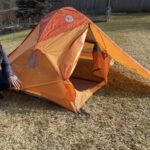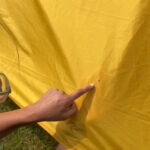Trekking and hiking poles can be a valuable tool when used correctly, but what features make one pair better than another?
Well, trekking poles come in a variety of designs with multiple features. These design considerations and features include the compact-ability of the poles, the pole shaft and grip material, and the type of pole tips.
Let’s take a deep dive into why these 4 trekking pole features are important so you know exactly what to look for and what to get!
Pro-tip: Make sure to check out How to Size and Use Trekking Poles Correctly before you make your purchase.
Article Contents:
- Are Telescoping or Folding Trekking Poles Better?
- Are Aluminum or Carbon Fiber Trekking Poles Better?
- Which Trekking Pole Grip Material is the Best – Cork or Foam?
- What Kind of Pole Tips Should You Use?
Are Telescoping or Folding Trekking Poles Better?

Probably the most important design feature of trekking poles is whether they are telescoping or folding.
As the name implies, telescoping poles can extend to a specified length suitable for the user.
- Usually telescoping trekking poles are made out of 3 pieces of tubing which nest inside of one another
- Each segment is connected with some sort of fastener to loosen or tighten the connection to adjust the overall length
Alternatively, folding hiking poles disconnect each segment from another (although not completely), which allows the poles to fold down into a flattened Z shape.
- To extend the poles into position, one end of the pole is pulled
- An internal cable becomes taut which creates tension to align each of the pole segments.
- The poles then lock into position with a built-in locking clip
- The top-most pole segment length can be adjusted to suit the user
Which Trekking Pole Design is Better for Traveling?
From a portability perspective, folding trekking poles are recommended for hikers that travel often. The overall pack dimensions of folding trekking poles are shorter than telescoping poles.
- The average packed length of folding trekking poles is 36 cm (14 inches), compared to telescoping trekking poles which is 66 cm (26 inches).
The smaller and more compact design of folding trekking poles allows you to place them easily into carry-on baggage while flying. Likewise, a small hiking daypack can easily store folding trekking poles.
Which Trekking Pole Design is Stronger?
If you’re interested in strength, telescoping trekking poles might be the way to go. This doesn’t mean folding trekking poles are weaker though. Both types are strong and durable, with plenty of stiffness to help keep you balanced while hiking.
That being said, telescoping poles generally have less components that might fail while on the trail and that aspect alone makes them a little more robust. It just relies on high-strength poles nesting within one another with clamps to keep everything in place.
Pro-tip: Some ultra-light tents are actually designed to integrate with trekking poles. And, both folding and telescoping trekking poles can be used to prop-up a tarp for a make-shift shelter.
Are Aluminum or Carbon Fiber Trekking Poles Better?

Trekking poles typically are made from either aluminum or carbon fiber. Both materials boast high strength-to-weight ratio and durability. However, each material has pros and cons when it comes to performance, cost, and maintenance.
Performance Difference
The act of walking or hiking requires you to swing your arms to provide stability and momentum. Trekking poles enhance this action by allowing you to plant another point of contact with the ground which helps stabilize your body and propels you forward.
- Carbon fiber trekking poles are on average 18% lighter than aluminum. This puts less strain on your arms and shoulders, which allows you to swing your arms faster and for longer without getting fatigued.
So, if you’re looking to push your personal performance to the maximum, carbon fiber trekking poles are the clear choice.
Cost Difference
From a manufacturing perspective, aluminum equipment is almost always cheaper than carbon fiber. To make aluminum hiking poles, heated aluminum is extruded to the desired diameter. This process is very simple and scalable which makes it low cost.
Alternatively, the use of carbon fiber requires multiple steps including lay-up, epoxy impregnation, vacuum sealing, and curing. The process is a lot more energy intensive which is why carbon fiber equipment comes at a premium price.
How do I know this? Well, I studied materials engineering!
Aluminum trekking poles are on average 50% cheaper than equivalent carbon fiber poles. So, if you’re on a budget, aluminum trekking poles are recommended.
Maintenance
Aluminum and carbon fiber are both extremely resilient materials. Both are non-corroding, which means you can use them in harsh environments without having to worry if they’ll breakdown over time.
Since aluminum is a metal, it can flex more than carbon fiber which can be a lot stiffer. That means when too much force is applied to aluminum it can bend without breaking. That also means it can be bent back without losing its structural strength.
Carbon fiber is less forgiving. Once bent beyond its limit, the internal fibers physically break. Once the fibers break, the structural integrity of the pole is compromised. Although it’s difficult to “fix” damage for both types of poles, if you’re accident prone or tend to abuse your gear then go with aluminum trekking poles. Aluminum poles are more forgiving and easier to maintain.
What Trekking Pole Grip Material is the Best – Cork or Foam?

The next important aspect of trekking poles is the grip material. Trekking pole grips are typically made from cork or foam. Both are lightweight options, but which pole grip material is the best? Rubber is also used, but mostly relegated to low-end, cheap trekking poles. For the sake of this analysis, rubber will be omitted.
Moisture Resistance
When it comes to sweaty palms and wet weather, cork is the far better option. It absorbs far less and actually wicks away moisture compared to foam which acts more like a high-density sponge.
Durability
Foam is a more durable and resilient material than cork which tends to dry out, crack and chip away over time.
For individuals who are less careful with their equipment, foam is a no-brainer. It can handle more abuse and maintain its integrity for much longer. However, if maintained and used correctly, cork can last a long time too. It just needs a bit more TLC.
Shock Absorption
Both foam and cork have good shock absorption but foam is slightly better. On gravel or rougher trails foams grips transfer less vibrations up and into your hands and wrists. This helps to extend your hiking time by reducing overall arm fatigue.
Cost
The cost of cork and foam comes down to natural versus synthetic material. Cork is a natural material which needs to be harvested and processed into its final shape. On the other hand, foam is a synthetic material which can be quickly and cheaply produced.
Foam grip trekking poles are typically cheaper than cork. For hikers who are budget conscious, foam is the more inexpensive option.
What Kind of Pole Tips Should You Use?

Some trekking poles allow you to change the tips to better suit the terrain and weather conditions. This adjustability lets you tailor the performance of the trekking poles to match the trail. Interchangeable pole tips and buckets are highly recommended if you hike in varying locales.
Rubber vs. Metal Carbide Tips
Higher-end trekking poles usually come with interchangeable rubber and metal carbide tips.
Rubber tips should be used on harder surfaces such as pavement or bare rock. Rubber tips have a larger contact area which can grip these surfaces better with less likelihood of slipping.
Metal carbide tips should be used on more yielding surfaces such as gravel or dirt trails as well as during winter hiking on snow or ice. Metal carbide tips have a finer point which allows them to penetrate the ground giving you a solid anchor point while walking.
Pro-tip: Some rubber tips are classified as “Nordic or fitness tips” which is just a fancy way of saying they’re designed for speed walkers.
Mud, Sand and Snow Buckets
Hiking in muddy, sandy or snowy conditions requires the use of special trekking pole tip buckets.
Buckets to pole tips are like snowshoes to hiking boots. They are essential for preventing the pole tips for sinking too far into softer ground. And they prevent you from loosing too much forward momentum if you’re constantly trying to lift your poles out of the ground with every step.
Mud and sand buckets are typically not too large whereas buckets for snow conditions are a bit wider. They sometimes snap into position or screw on depending on the pole model and design.
This little design feature can make a massive difference to your hiking ability so make sure to consider it before you buy!
More Trekking / Hiking Pole Related Info…
Related Posts
- Backpack Search | 30L Backpack Buyer’s GuideThere are thousands of backpacks on the market today. And, with so many models and… Read more: Backpack Search | 30L Backpack Buyer’s Guide
- How to Buy a Camping TentThe sheer number of tents on the market these days is out of control. There… Read more: How to Buy a Camping Tent
- What is Sleeping Pad R-Value? Insulation ExplainedOne of the best ways to sleep comfortably while camping during cooler conditions is by… Read more: What is Sleeping Pad R-Value? Insulation Explained
- Pros and Cons of Buying a Used Tent – Is It Actually Worth It?Whether it’s from a financial standpoint or an environmental one, buying a used tent might… Read more: Pros and Cons of Buying a Used Tent – Is It Actually Worth It?




